Australian Data
ANZ Jobs Ads
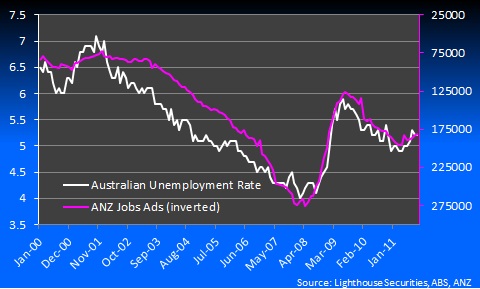 Total jobs ads according to the ANZ job ads report fell for the 4th straight months and 6th time in the past 7th months in October where they fell by 0.7% with the annual pace of growth slowing to 1.8%. However since peaking in March jobs ads have fallen 7.2% or at an annualised rate of 12%. Both internet and newspaper ads have been falling however newspaper ads have performed markedly worse and are now down 16.7% over the past 12 months while internet ads, which makes up 96% of all ads are up 2.8% over the past 12 months but down 6.75% since March. The weakness in jobs ads suggests further softness in the labour market outcomes over the months ahead.
Total jobs ads according to the ANZ job ads report fell for the 4th straight months and 6th time in the past 7th months in October where they fell by 0.7% with the annual pace of growth slowing to 1.8%. However since peaking in March jobs ads have fallen 7.2% or at an annualised rate of 12%. Both internet and newspaper ads have been falling however newspaper ads have performed markedly worse and are now down 16.7% over the past 12 months while internet ads, which makes up 96% of all ads are up 2.8% over the past 12 months but down 6.75% since March. The weakness in jobs ads suggests further softness in the labour market outcomes over the months ahead.
Trade Balance
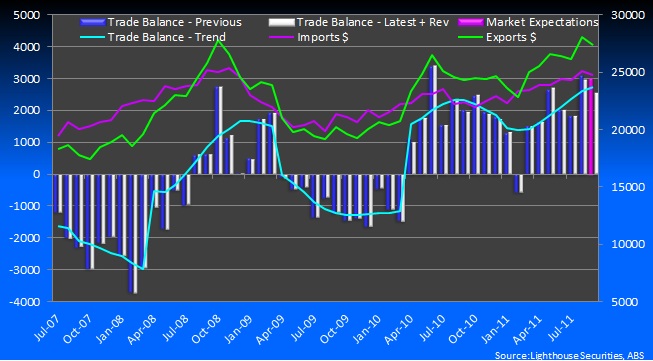 Australia’s trade surplus narrowed more than expected in September, falling from a revised $2.95bln to $2.56bln after it was expected to drop from $3.1bln to $3bln. The bigger than expected drop was driven by a 2.5% fall in exports which was in turn driven by a 24% drop in non-monetary gold and a 1.5% drop in non-rural goods. Service exports also fell while rural goods rose. Imports also fell over the month, dropping 1.3% driven by falls in consumption and intermediate goods while capital goods exports jumped 6.4%. Exports of Coal from the flood effected QLD region through the Gladstone port continue to improve.
Australia’s trade surplus narrowed more than expected in September, falling from a revised $2.95bln to $2.56bln after it was expected to drop from $3.1bln to $3bln. The bigger than expected drop was driven by a 2.5% fall in exports which was in turn driven by a 24% drop in non-monetary gold and a 1.5% drop in non-rural goods. Service exports also fell while rural goods rose. Imports also fell over the month, dropping 1.3% driven by falls in consumption and intermediate goods while capital goods exports jumped 6.4%. Exports of Coal from the flood effected QLD region through the Gladstone port continue to improve.
NAB Business Survey
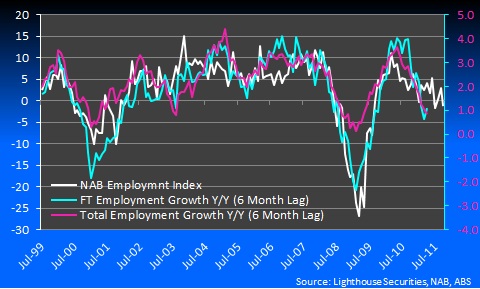 There were some small moves in business confidence and conditions this month with the former up 3 points to 2 while the latter fell 3 points to -1 after large moves recently however there was some more significant moves in a number of the sub-components. The weakness in conditions was driven by a continued deterioration in profitability and trading condition which are both deeply negative while forward orders and stocks are also in negative territory. Inflationary pressures are clearly waning with the prices and labour cost index both falling sharply while capacity utilisation continued to trend lower. The key however was the fall in the employment index which is negative for the second time in the past 4 months at -1 which is also the second weakest reading since August 2009
There were some small moves in business confidence and conditions this month with the former up 3 points to 2 while the latter fell 3 points to -1 after large moves recently however there was some more significant moves in a number of the sub-components. The weakness in conditions was driven by a continued deterioration in profitability and trading condition which are both deeply negative while forward orders and stocks are also in negative territory. Inflationary pressures are clearly waning with the prices and labour cost index both falling sharply while capacity utilisation continued to trend lower. The key however was the fall in the employment index which is negative for the second time in the past 4 months at -1 which is also the second weakest reading since August 2009
Westpac Consumer Survey
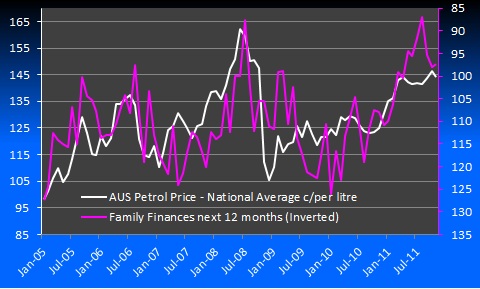 There was a solid increase in consumer confidence in November, largely driven by the decision by the RBA to cut the cash rate by 25bp at their November meeting. The confidence index jumped 6.3% back towards its long run average while the conditions index was up a more subdued 3.9% and the expectation index rose 8%. However it was the sub-components, which like the NAB Business survey provided a much different picture. Consumer’s confidence in the economy was the major beneficiary of the RBA decision to cut rates with expectations over the next year up 18.8% while expectations over the next 5 years jumped 7.4%. Family finances however were much more interesting and compared to a year ago, when the RBA last hiked, the index was up 7.1% however family finances for the year ahead actually fell 0.8%. Cost of living???
There was a solid increase in consumer confidence in November, largely driven by the decision by the RBA to cut the cash rate by 25bp at their November meeting. The confidence index jumped 6.3% back towards its long run average while the conditions index was up a more subdued 3.9% and the expectation index rose 8%. However it was the sub-components, which like the NAB Business survey provided a much different picture. Consumer’s confidence in the economy was the major beneficiary of the RBA decision to cut rates with expectations over the next year up 18.8% while expectations over the next 5 years jumped 7.4%. Family finances however were much more interesting and compared to a year ago, when the RBA last hiked, the index was up 7.1% however family finances for the year ahead actually fell 0.8%. Cost of living???
Housing Finance
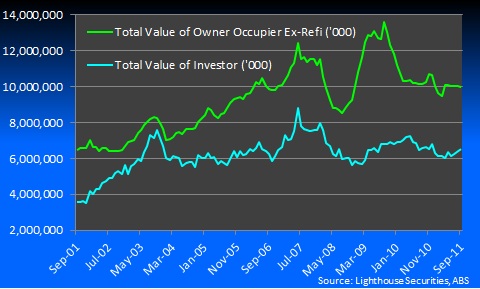 There continues to be a recovery in the number of housing approvals however the bulk of the improvement is being driven by an increase in re-financing as increased competition and falling fixed rates entices consumers to chase a better deal. The value of owner occupier commitments has been flat for some time now while investor’s values have picked up however it is not clear how much of this is due to refinancing. There has also been a pickup in first home buyer activity as they rush to secure stamp duty exemptions that expire at the end of the year, bringing forward demand. The static level of housing finance at subdued levels is resulting in a grinding fall in house price values.
There continues to be a recovery in the number of housing approvals however the bulk of the improvement is being driven by an increase in re-financing as increased competition and falling fixed rates entices consumers to chase a better deal. The value of owner occupier commitments has been flat for some time now while investor’s values have picked up however it is not clear how much of this is due to refinancing. There has also been a pickup in first home buyer activity as they rush to secure stamp duty exemptions that expire at the end of the year, bringing forward demand. The static level of housing finance at subdued levels is resulting in a grinding fall in house price values.
Employment
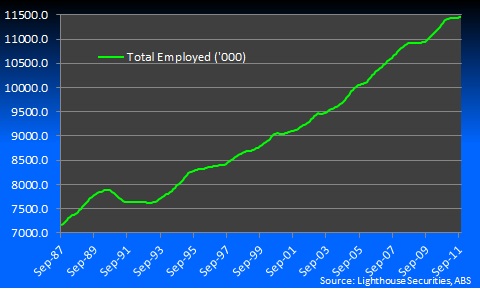 The Australian employment market posted its second monthly gain in October with total jobs growth of 10.1k which was in line with market estimates. The split was also favourable with full time jobs up 20k while part time jobs fell 9.9k and a slight dip in the participation rate (unrounded) saw the unemployment rate dip from 5.3 to 5.2 but is still trending higher. Total employment growth still remains soft which is evident in the chart which shows the slowdown during 2011. The positive is that despite the weakness in the non-mining sector of the economy and the strengthening headwinds from offshore, we are yet to see widespread job losses
The Australian employment market posted its second monthly gain in October with total jobs growth of 10.1k which was in line with market estimates. The split was also favourable with full time jobs up 20k while part time jobs fell 9.9k and a slight dip in the participation rate (unrounded) saw the unemployment rate dip from 5.3 to 5.2 but is still trending higher. Total employment growth still remains soft which is evident in the chart which shows the slowdown during 2011. The positive is that despite the weakness in the non-mining sector of the economy and the strengthening headwinds from offshore, we are yet to see widespread job losses
Offshore Data
German Industrial Production
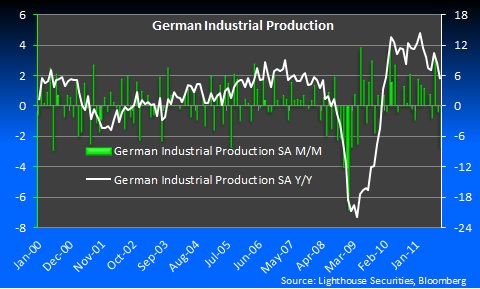 Industrial Production in Germany stalled in September with total production falling by 2.7% which is the third fall in the past 4 months which has seen tha annual increase slow from 10.4% to 5.4%. A 3% fall in manufacturing and mining production was the main driver behind the fall which consisted of a 2.8% fall in intermediate goods and a 4% fall in capital goods. The production of consumer goods rose 1.1%, driven by a 1.6% increase in non-durable goods while durable goods production fell 0.9%. Of the remaining components Energy production fell 0.7% while Construction was down 0.8%
Industrial Production in Germany stalled in September with total production falling by 2.7% which is the third fall in the past 4 months which has seen tha annual increase slow from 10.4% to 5.4%. A 3% fall in manufacturing and mining production was the main driver behind the fall which consisted of a 2.8% fall in intermediate goods and a 4% fall in capital goods. The production of consumer goods rose 1.1%, driven by a 1.6% increase in non-durable goods while durable goods production fell 0.9%. Of the remaining components Energy production fell 0.7% while Construction was down 0.8%
German International Trade
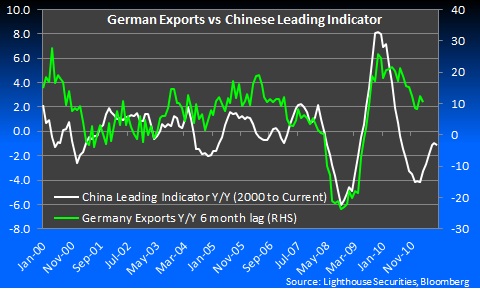 Like German industrial production, their international trade figures are starting to show the strains of a slowing Eurozone and global economy. Export growth continues to slow but remains positive, with exports climbing by 0.9% in September however the annual pace of growth slipped back to 10.4% however imports have flatlined since May in a sign that demand and forward orders are coming under increasing pressure. Indeed the relationship between the Chinese leading indicator and German exports, which has been quite a good leading indicator for German exports, continues to suggest a further slowdown over the months ahead.
Like German industrial production, their international trade figures are starting to show the strains of a slowing Eurozone and global economy. Export growth continues to slow but remains positive, with exports climbing by 0.9% in September however the annual pace of growth slipped back to 10.4% however imports have flatlined since May in a sign that demand and forward orders are coming under increasing pressure. Indeed the relationship between the Chinese leading indicator and German exports, which has been quite a good leading indicator for German exports, continues to suggest a further slowdown over the months ahead.
China Inflation
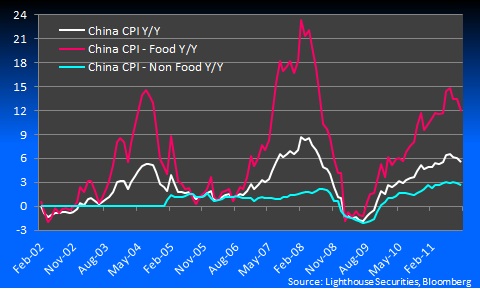 Chinese officials attempts to rein in inflation are finally starting to gain traction. The annual pace of inflation has slowed over the past three months from a peak of 6.5% to 5.5%, however until the latest reading it had been from substantial increase from 2010 dropping out of the calculation. In October the inflation index rose by 0.1%. A slowing in the pace of food inflation has largely been behind the slowing in overall inflation. With a 1.1% monthly rise from November 2010 to drop out next month the annual rate is likely to fall further.
Chinese officials attempts to rein in inflation are finally starting to gain traction. The annual pace of inflation has slowed over the past three months from a peak of 6.5% to 5.5%, however until the latest reading it had been from substantial increase from 2010 dropping out of the calculation. In October the inflation index rose by 0.1%. A slowing in the pace of food inflation has largely been behind the slowing in overall inflation. With a 1.1% monthly rise from November 2010 to drop out next month the annual rate is likely to fall further.
China International Trade
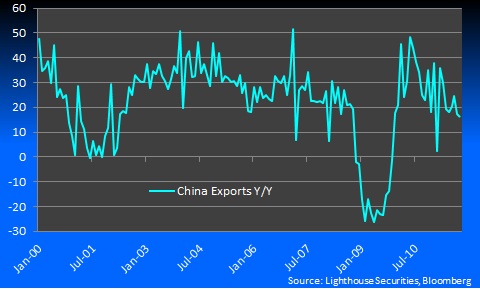 Chinese exports and imports are showing increasing signs of slowing with exports dropping for the third straight month while imports have fallen for the past two months. In October exports fell 7.2% with the annual pace of growth slowing to 15.9% while imports fell 9.5% however their annual rate of growth increased to 28.7%. With over a quarter of Chinese exports going directly to Europe, the slowdown that is in train acorss the Eurozone is likely to have a substantial effect on the Chinese economy over the coming quarters.
Chinese exports and imports are showing increasing signs of slowing with exports dropping for the third straight month while imports have fallen for the past two months. In October exports fell 7.2% with the annual pace of growth slowing to 15.9% while imports fell 9.5% however their annual rate of growth increased to 28.7%. With over a quarter of Chinese exports going directly to Europe, the slowdown that is in train acorss the Eurozone is likely to have a substantial effect on the Chinese economy over the coming quarters.
US Consumer Credit
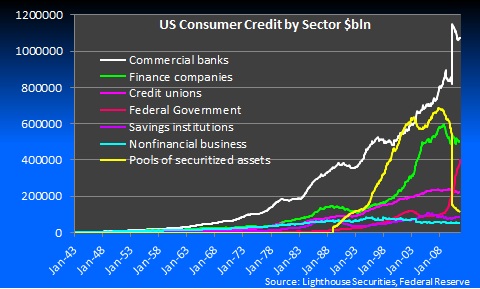 After falling close to $10bln in August, consumer credit bounced back in September, rising by $7.4bln which was more that the $5.15bln that the market was expecting. The recovery in consumer credit continues to be drive by growth in non-revolving credit such as student and auto loans while revolving credit such as credit cards has been largely unchanged over the past few months after falling for almost 3 straight years following the onset of the Global Financial Crisis. The government’s role in consumer credit continue to grow and they now account for 16.5% of total outstandings which is the highest on record.
After falling close to $10bln in August, consumer credit bounced back in September, rising by $7.4bln which was more that the $5.15bln that the market was expecting. The recovery in consumer credit continues to be drive by growth in non-revolving credit such as student and auto loans while revolving credit such as credit cards has been largely unchanged over the past few months after falling for almost 3 straight years following the onset of the Global Financial Crisis. The government’s role in consumer credit continue to grow and they now account for 16.5% of total outstandings which is the highest on record.
US Consumer Confidence
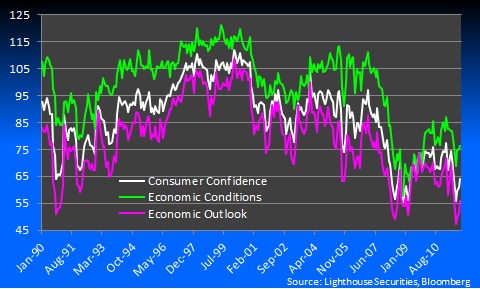 The preliminary reading of the University of Michigan consumer sentiment index saw confidence rise more than expected in November with the index climbing to 64.2 from 60.9 against expectations of a rise to 61.5. The economic outlook index also rose strongly to 56.2 from 51.8 and has now climbed for three straight months after hitting an all time low of 47.4 in August while the improvement in the economic conditions index was far more subdued with it rising from 75.1 to 76.6. Overall however all three readings remain weak by historical standards.
The preliminary reading of the University of Michigan consumer sentiment index saw confidence rise more than expected in November with the index climbing to 64.2 from 60.9 against expectations of a rise to 61.5. The economic outlook index also rose strongly to 56.2 from 51.8 and has now climbed for three straight months after hitting an all time low of 47.4 in August while the improvement in the economic conditions index was far more subdued with it rising from 75.1 to 76.6. Overall however all three readings remain weak by historical standards.